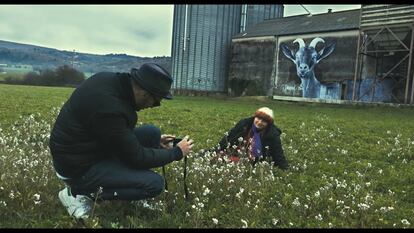Eight great documentaries from the 21st century that you can watch at home
Here are just some of the films that have garnered critical acclaim and wide audiences since being reintroduced to streaming services


The last 20 years have been key for the documentary genre. After decades of being considered a minor form, the non-fiction film has managed to make major strides in terms of budgets, production quality, awards and audiences. Documentaries now tend to have a greater artistic sensibility, playing with narrative modes and ideas about subjectivity. On-demand digital platforms consistently include them as main attractions in their catalogues.
Here are just some of the documentary films that have garnered critical acclaim and wide audiences since being reintroduced to streaming services:
Waltz with Bashir (2008), by Ari Folman
This semi-autobiographical account uses animation to confront the collective amnesia of the Israeli occupation of Lebanon, recalling the massacre of Palestinian refugees in Sabra and Shatila by Israeli soldiers in 1982. This hypnotic documentary conveys what it means to be a violent actor, giving way to artistic sensitivity and psychological depth. It is available on Apple TV.
Faces and places (2017), by Agnès Varda
In the early 1980s, the Belgian director of this documentary toured the murals of Los Angeles, reflecting the city’s multiculturalism in Mur Murs (1981). More than 30 years later, she embarked on a journey through rural France with street artist JR, nearly six decades her junior. Together, they create a portrait of a country through murals.
The film brings together some of Varda’s artistic constants: a clean gaze to look at ordinary people, the miracle of eternal curiosity and how art comes from humanism. It can be viewed on Rakuten TV, Apple TV and Filmin. A good number of Varda’s previous documentaries are also available on MUBI.
Honeyland (2019), by Tamara Kotevska and Ljubomir Stefanov
The relationship between the planet and the humans who inhabit it is increasingly complicated and toxic in every possible way. Perhaps this is why a documentary made in North Macedonia connected with international audiences a few years ago.
In the film, the directors follow the work of Hatidze Muratova, a middle-aged bee collector who lives in Bekirlija, a tiny village without electricity or running water hundreds of kilometres away from another human being… other than her own mother.
Muratova only keeps half of the precious honey she collects, leaving the rest to its rightful owners: the bees. Many elements feed the visual poetry of this sustainable and anti-capitalist fable that reminds us that, at least from time to time, another way of life is possible. It can be watched on Amazon Prime Video.
Fire at sea (2016), by Gianfranco Rossi
The Italian filmmaker details life on the humble Sicilian island of Lampedusa, which is closer to the African coast than to Europe. In recent years, it has become a gateway for immigration. The film keeps in mind that more than 20,000 people have drowned during the journey to the island since the 1990s… but it is not intended to be a journalistic exercise. The daily life of the local people occupies most of the screen time. There are no apologies or confrontations in this story, which prefers to limit itself to conveying the sadness that is shipwrecked on the island’s shores. Fire at sea is currently streaming on the Sundance Now Amazon Channel.
Grizzly man (2005), by Warner Herzog
The famous German filmmaker follows in the antics of naturalist Timothy Treadwell. Treadwell – an aspiring actor and recovering alcoholic at the time of filming – spent 13 summers living among bears in an Alaskan nature reserve, without weapons or training. He recorded his experiences… until a bear ended his delusions and killed him, along with his girlfriend.
In the film, Herzog uses some material from his personal archive to analyze human madness, in the style of his Fitzcarraldo (1982), rather than going the route of the idyllic nature documentary. Grizzly man can be viewed on Pluto TV.
Searching for Sugar Man (2012), directed by Malik Bendjelloul
This is the curious story about a mysterious music star in a pre-globalized world. Sixto Rodríguez was an unknown singer-songwriter in the 1960s, until two music producers heard his melodies in a Detroit bar. They recorded two albums of his songs, but mainstream fame remained out of reach. However, Rodríguez did find success in Apartheid South Africa, via the pirated recordings of his work that were circulated. Swedish director Bendjelloul reconstructs the story of this musician decades later, in a didactic and emotional way, while confronting the urban legends surrounding his figure. The film is on Amazon Prime Video and Apple TV.
The look of silence (2014), by Joshua Oppenheimer
In Indonesia, between 1965 and 1966, a military coup resulted in the extermination of nearly half-a-million people, in what was one of the largest genocides committed in recent history. British director Joshua Oppenheimer recounted this in The act of killing (2012), a classic of the documentary genre, but two years later, he created a more personal story around the same theme. He does this through the gaze of a relative of one of the men executed. The protagonist of the film, Adi, is an eye doctor who was born shortly after his brother’s death. With his identity partially concealed, he seeks answers for himself and his family about those responsible for his older brother’s murder. Oppenheimer’s films are available on Hoopla, Hulu, Amazon Prime and Fandor.
Tu suscripción se está usando en otro dispositivo
¿Quieres añadir otro usuario a tu suscripción?
Si continúas leyendo en este dispositivo, no se podrá leer en el otro.
FlechaTu suscripción se está usando en otro dispositivo y solo puedes acceder a EL PAÍS desde un dispositivo a la vez.
Si quieres compartir tu cuenta, cambia tu suscripción a la modalidad Premium, así podrás añadir otro usuario. Cada uno accederá con su propia cuenta de email, lo que os permitirá personalizar vuestra experiencia en EL PAÍS.
¿Tienes una suscripción de empresa? Accede aquí para contratar más cuentas.
En el caso de no saber quién está usando tu cuenta, te recomendamos cambiar tu contraseña aquí.
Si decides continuar compartiendo tu cuenta, este mensaje se mostrará en tu dispositivo y en el de la otra persona que está usando tu cuenta de forma indefinida, afectando a tu experiencia de lectura. Puedes consultar aquí los términos y condiciones de la suscripción digital.
More information
Últimas noticias
Most viewed
- Reinhard Genzel, Nobel laureate in physics: ‘One-minute videos will never give you the truth’
- Oona Chaplin: ‘I told James Cameron that I was living in a treehouse and starting a permaculture project with a friend’
- Pablo Escobar’s hippos: A serious environmental problem, 40 years on
- Why we lost the habit of sleeping in two segments and how that changed our sense of time
- Charles Dubouloz, mountaineering star, retires at 36 with a farewell tour inspired by Walter Bonatti













































